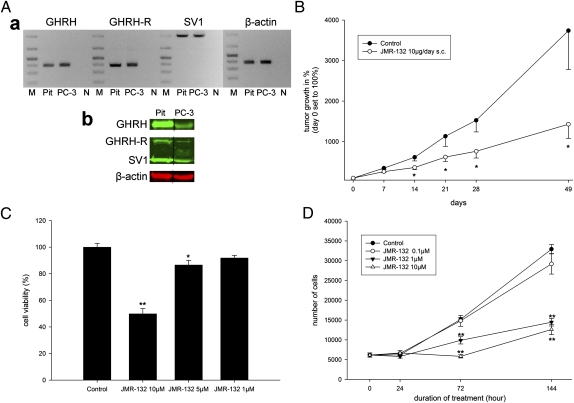Fig. 1.
Expression of target receptors GHRH-R, SV1, and GHRH ligand and inhibition of growth of PC-3 human androgen-independent prostate cancer in vivo and in vitro. (A) Real-time RT-PCR. (a) Analysis of GHRH, GHRH-R, SV1, and β-actin in cultured PC-3 cells. Human pituitary (Pit) was used as positive control. DNA molecular weight marker is shown in lane M. Negative controls with no template in real-time PCR are shown in lane N. (b) Western blot analysis of GHRH, GHRH-R, and SV1 in cultured PC-3 cells. Representative blots of three independent experiments are presented and include β-actin as an internal standard. Grouping of representative bands for each experimental group was performed digitally. (B) The GHRH antagonist JMR-132 inhibits the growth of s.c. PC-3 prostate cancer xenografted into nude mice. Statistical analysis was performed by one-way ANOVA, followed by Bonferroni t test. Asterisks indicate a significant difference (P < 0.05 compared with control). (C) MTS cell-viability assay performed on PC-3 prostate cancer cells treated with different concentrations of the GHRH antagonist JMR-132 reveals a dose-dependent inhibitory effect. *P < 0.05 and **P < 0.01 compared with control by Student's t test. (D) Cell proliferation (absolute cell-number counts) of the PC-3 prostate cancer cell line treated with different doses of the GHRH antagonist JMR-132. **P < 0.01 compared with control by Student's t test. Data are shown as means ± SEM.

